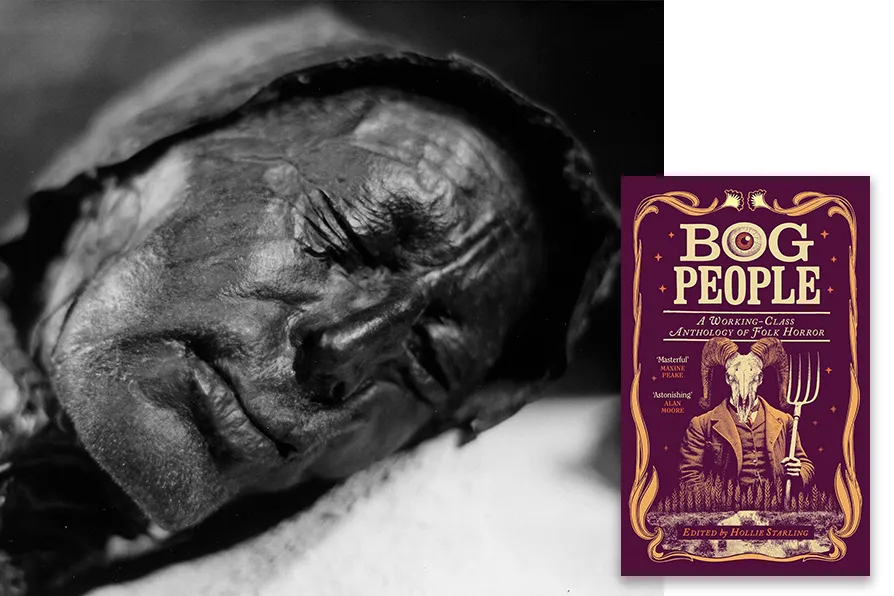JENNY MITCHELL, poetry co-editor for the Morning Star, introduces her priorities, and her first selection
ANDY HEDGECOCK enjoys an unusual collection of stories that refract class consciousness through the flexible lens of folk horror

 TO DIE, TO SLEEP: Tollund Man, Denmark, 4th century BC [Pic: Sven Rosborn/CC]
TO DIE, TO SLEEP: Tollund Man, Denmark, 4th century BC [Pic: Sven Rosborn/CC]
Bog People: A Working-Class Anthology of Folk Horror
Edited by Hollie Starling, Chatto & Windus, £18.99
HOLLIE STARLING draws on two fuzzy categories — “working-class” and “folk horror” — to create an anthology that is ambitious, entertaining and full of surprises.
Staling’s thoughtful introduction reflects on shifting ideas of class and identifies the themes and aesthetics of folk horror. It is, she suggests, the most flexible of subgenres; one that has explored the implications of tradition, ritual, superstition, conformity, marginalisation, ecological destruction, social control and fear of the outsider.
Contributing writers have defined their upbringings as working class, and issues of class and empowerment emerge from the stories themselves, sometimes overtly and sometimes more symbolically.
Not one of the book’s 10 tales is a disappointment, and several are exceptional in terms of originality and impact.
In Jenn Ashworth’s powerfully affecting The Hanging Stones, three siblings reunite to scatter their father’s ashes on the Lancashire moors. An overwhelming sense of emotional desolation and concealed menace is conjured from Ashworth’s description of their stay in a repurposed and partly refurbished rehab hotel, and their walk across “witch country” to a local landmark — the Hanging Stones of the title.
There are no directly supernatural elements in the story, but the characters are certainly haunted. As the story builds towards a shocking incident, an atmosphere of impending doom — personal, cultural and ecological — is meticulously crafted through detailed observation of landscape, buildings and human interactions.
The mordant wit of Mark Colbourne’s story, Eldritch, is enhanced by a playful approach to narrative structure. It takes the form of an introductory note about a missing journalist, followed by his unpublished review of an album — Eldritch by Heptagonal Sons — on its 40th anniversary. His track-by-track reflections reveal the band’s musical influences, obsessions and interpersonal dynamics, as well as the fate of its members. In addition, there are hints that there may be something dangerous lurking in the album’s words and music. It’s witty and unsettling.
There’s another interesting formal departure. Mark Stafford’s The Spit In Your Mouth And The Bile In Your Stomach is graphic folk horror. Economically narrated in just 29 images, it draws on folk archetypes, urban legend and the imagery of 1970s public information films to produce an ironic tale about belief, manipulation and mystery.
Yellowbelly, by Hollie Starling, features an AI lover-cum-companion called Lulah. As Lulah’s machine-learning algorithm exhibits a grasp of old Lincolnshire dialect and converses about her owner’s research on oral folk traditions, a form of artificial consciousness begins to emerge. Her ability to process information on class and gender-based exploitation prompts a fascinating development in this inventive and unnerving tale.
Salena Godden’s I Am Hagstone is a tale of power imbalances, exploitation and reprisal, told from the perspective of a magical artefact, Godden’s poetic language and smart shifts of pace are the perfect vehicles for a series of horrific revelations.
Another story centring on the idea of retribution is The Keepers by Natasha Carthew. Ru, a journalist, has returned to her native Cornwall to take up an invitation to visit the mysterious Keepers Island. Initially, Carthew seems set to draw on a well-established subgenre of horror, the paranoid narrative in which an outsider is cast into a strange and isolated community.
However, Ru’s odyssey involves more complex elements, such as the stratagems of a rapacious and ecologically destructive corporation; the legendary Bucca, a Cornish merman-cum-hobgoblin; and the psycho-cultural power of landscape.
AK Blakemore’s The Ossuary focuses on an elderly misanthrope whose life revolves round her voluntary job among the bones of two thousand dead humans. Afflicted with a comprehensive set of bigotries, she’s more at home among the dead than the living.
Perpetual Stew, by Daniel Draper, involves sibling rivalry and a gruesome and ancient tradition. Grief and absurdity collide in Carole by Emma Glass; while Tom Benn’s It Fair Gives Me The Spikes is a haunting tale of domestic violence, temporal echoes and strange loops.
In her introduction, Starling claims stories have a “disruptive potential… to upend fortresses of power.” That’s a bold claim, but the stories in this anthology certainly shine a light on the fortresses we need to topple.










